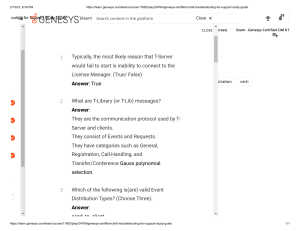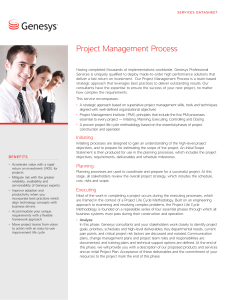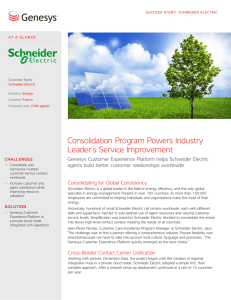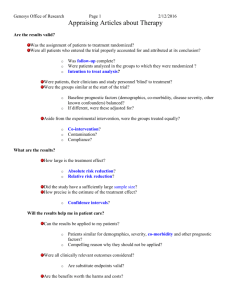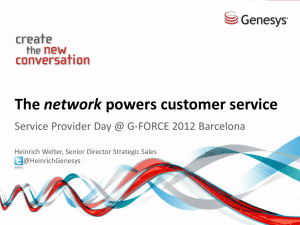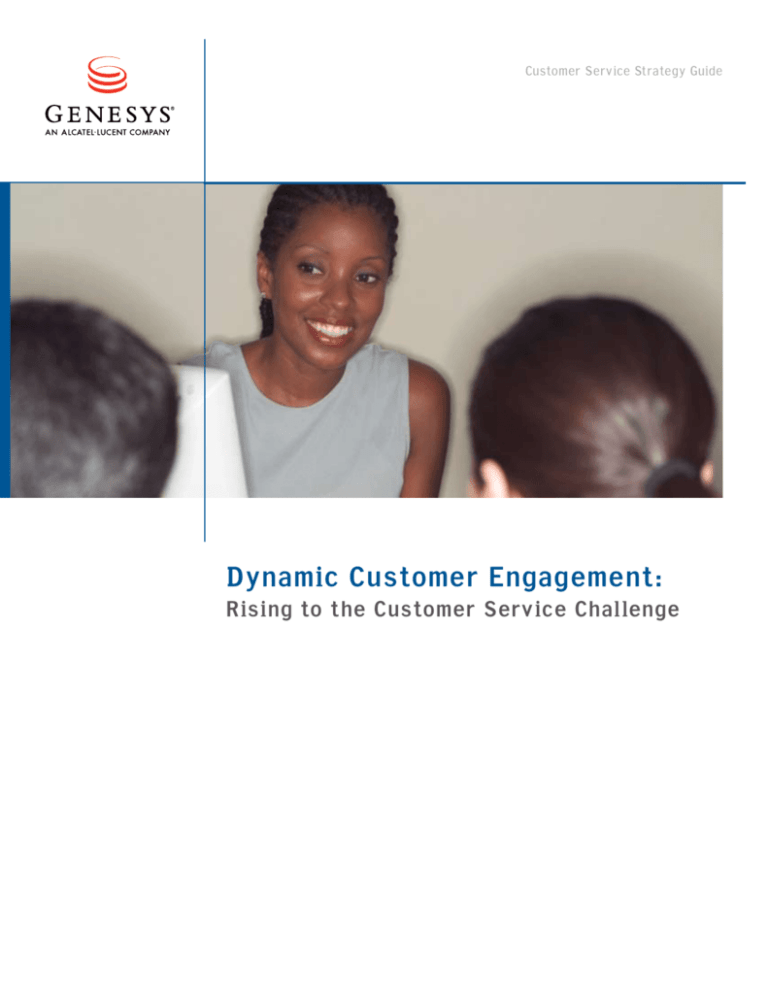
Customer Service Strategy Guide
Dynamic Customer Engagement:
Rising to the Customer Service Challenge
Customer Service Strategy Guide: Dynamic Customer Engagement: Rising to the Customer Service Challenge | page 2
Introduction
T
Companies today
are being forced
to re-think how
they interact with
customers —― due
to shifting market
dynamics, recent
innovations, and
a new generation
of consumers who
expect enterprises
to support customer
service via a variety
of touch points.
wenty years ago, customer service
was nearly universally limited to
face-to-face retail interactions or
to call centers. But today enterprises face
the challenge of addressing a new generation of consumers who expect companies
to support customer service via a variety
of touch points — Web chat, video selfservice, the back office, SMS text
messaging, and many other communication channels. Clearly, these shifting market
dynamics and new innovations have
radically altered the way companies
interact with customers.
What’s more, purchasing decisions and
impulses are now based upon a new set of
criteria and rules that bestow tremendous
power on the customer, while marginalizing
the power of traditional marketing.
>>Multi-channel creates multicomplexity: Today, consumers can
exercise their purchasing power on a
variety of fronts: in the store, via the
phone, from a computer, or over a
smart phone, and they often choose to
communicate with companies via Web,
chat, e-mail, mobile, and fax. These
multiple channels, while providing
greater convenience for the customer,
create new challenges and headaches for a
company because they are often siloed —
operating in isolation from one another.
For example, a customer may research a
product over the Internet, call the contact
center with questions, and later walk
into the store to “seal the deal.” In this
scenario, the customer held three separate
conversations with the same company,
but the company lost an opportunity at
each step, since each of the channels was
unaware of the previous interactions.
>>Customer engagement is an
enterprise problem: When interacting
with a company, customers are oblivious
and indifferent to the many primary
and secondary resources supporting
their specific needs — they just want
their issue resolved ASAP. Unfortunately,
in today’s tight economy where
profitability is king, many companies are
neglecting the strategic importance of
customer service across the enterprise.
But customer service is no longer
confined to the four walls of the contact
center, and is now the responsibility
and obligation of the entire enterprise.
The contact center, customer service
department, back office, marketing,
outsourcers, and branch/remote
resources all play an integral role in
customer engagement and customer
service.
>>The power has shifted to the
customer: In the past, customers that
received poor service had little recourse
other than to complain to friends, and
to take their business elsewhere. Today,
customers have a booming megaphone.
Blogs, Wikis, Twitter, Facebook,
YouTube, and other social media
tools provide a tremendous platform
where customers can express their
dissatisfaction (and satisfaction), and
companies have no control over
content posted.
Customer Service Strategy Guide: Dynamic Customer Engagement: Rising to the Customer Service Challenge | page 3
Adapting to Meet Rising Customer Needs and Expectations
How can a company best prepare to meet the challenge of such dynamic environments? First, they must recognize that the
measures of success have changed. While cost reduction remains a top goal in 2009, customer retention and revenue generation
have become equally important. Therefore, for many companies, the pendulum has swung from a focus on traditional priorities
toward gaining a more holistic view of the customer.
To that end, savvy companies are implementing key Dynamic Customer Engagement strategies. Dynamic Customer Engagement
strengthens customer relationships and optimizes business outcomes by proactively engaging customers with the ideal customer
service experience through any channel. Unlike traditional customer service, which was separated from the core of the business
and largely seen as a cost center designed to minimize overhead and quickly complete interactions, Dynamic Customer Engagement aims to identify the customer need, transactions, and value in order to appropriately engage with them and strengthen the
relationship. Why is this important? Because customer relationships will drive long term growth objectives in four areas:
1.Likelihood to recommend: Engaged customers make brand recommendations to friends
2.Willingness to purchase more: Engaged customers purchase additional products
3.Reluctance to switch: Engaged customers are loyal to a brand or company
4.Ability to contain costs: Engaged customers are the least-expensive to service
Ingredients for Engagement and Loyalty
Differentiating through Dynamic Customer Engagement requires a long-term commitment, and should encompass an enterprise framework that addresses the challenges inherent in the following five customer-engagement ingredients: Interactions,
Resources, Infrastructure, Processes, and Performance.
1.Interactions: Every interaction with a company creates a lasting impression on the customer. And today companies
must scramble to successfully manage many different types of interactions — a challenge that is compounded as
customers jump channels during the course of a sales or service process. In addition, social media is providing an
empowering platform for customers to very publicly discuss a company’s product and brand — for better or worse.
2.Resources: A company’s brand connects with customers through a plethora of resources including agents, outsourcers,
knowledge workers, at-home agents, back-office, and automated systems. These resources represent the engine for
growth objectives and should be optimized for efficiency, effectiveness, and driving the bottom line.
3.Infrastructure: Legacy infrastructure and disparate hardware and application systems exist in every IT infrastructure.
The challenge is to cobble these individual parts together into a powerful customer engagement machine. The
synergy of these assets will support a company’s customer engagement strategy by empowering every employee
responsible for customer service, sales, and support.
4.Processes: Every customer interaction incorporates an underlying customer process. For example, calling the
insurance company to file a claim automatically initiates a process involving many organizations across the enterprise.
Often these processes are managed independently in the back office through a Business Process Management (BPM)
or Service Request system. Unfortunately, many of these systems lack the visibility into resource availability and
business priority to meet service level requirements. The challenge is how to ensure that the back office achieves
similar efficiencies as its front-office/contact center counterparts.
5.Performance: Since customer engagement is driving growth objectives, senior executives and business managers are
scrutinizing customer service operations. Unfortunately, most Key Performance Indicators (KPIs) and reports don’t
provide the visibility into how the customer experience and engagement impact business outcomes. Performance
Management and analytics will increasingly play an important role in helping business executives gauge customer
engagement effectiveness and guide the decision-making process.
Customer Service Strategy Guide: Dynamic Customer Engagement: Rising to the Customer Service Challenge | page 4
Strategies for Creating
Brand Loyalty
Savvy companies are
implementing key Dynamic
Customer Engagement
strategies to strengthen
customer relationships
and optimize business
outcomes by proactively
engaging customers
with the ideal customer
service experience
through any channel.
As detailed above, Interactions, Resources,
Infrastructure, Processes, and Performance
represent the five key customer engagement
ingredients. But how can companies develop
a cohesive, actionable strategy that brings
them all together to help drive growth?
Interactions
In developing its strategy, an organization
must plan for a wide variety of customer
interactions which can occur through any
communication channel, without losing
continuity or starting the transaction over.
Even in a single channel, such as the phone,
customers should be able to start in voice
self-service and easily move to a human
without having to be re-verified or repeat
their transaction details from the start.
Cross-channel Conversations: Every day,
customers unwittingly have multiple discreet
conversations with the same company. For
example, a customer may receive an e-mail
offer from the online marketing organization
of a bank. The customer may then research
the offer on the Web site and perhaps
engage in a live Web chat with an agent.
The customer might later call the contact
center to dispute an item on a recent bank
statement. Finally, the customer might walk
into the branch to conduct some regular
business. In this scenario, the customer had
five separate interactions with the bank
through e-mail, Web self-service, Web chat,
phone, and branch. Unfortunately, the bank
was unaware of these separate conversations
and missed several opportunities to connect
the dots and perhaps up-sell on the initial
e-mail offer.
Most enterprises have created a siloed
approach to their many channels. E-mail
and chat resources often reside outside
of the phone-centric contact center. As
customers increasingly jump between
channels, companies must begin to tear
down the walls separating their voice and
non-voice channels and link the discrete
interactions that occur over time into one
conversation. If an interaction begins in
one channel, it must seamlessly transition
complete customer data when another
channel is used. This process requires a
comprehensive technology and operational strategy shift:
• Technology: How can companies leverage and virtualize existing investments
within each of the silos to create a virtualized environment across all channels?
Most organizational silos are comprised of
legacy ACD, CTI, and IVR systems, and
e-mail, chat, and SMS applications. Each
of these different systems should be aware
of each discrete interaction and supporting customer data touching an individual
customer.
• Operational: As the technology platforms across the many silos are virtualized, companies will need to leverage
their entire pool of resources to effectively manage all of their voice, Web, and
mobile channels.
Companies have a reasonable degree of
control over inbound voice,Web, and mobile
interactions, but when these interactions
migrate to social medial channels such as
Twitter, Facebook, and other social forums,
the company abdicates control and the
discussion is dictated by the consumer. If
managed properly, however, these vehicles
can become constructive brand feedback
Customer Service Strategy Guide: Dynamic Customer Engagement: Rising to the Customer Service Challenge | page 5
forums to advance brand loyalty. As companies appropriately engage and respond to social
media posts, tweets, and forum rants, they will drive a powerful customer dialogue that recruits
a new army of brand enthusiasts.
Resources
Competent resources can make a tremendous difference in minimizing costs while also
delivering high levels of customer service, combating customer defections, and attaining
revenue objectives.
Enterprise Resource Optimization: In today’s challenging economic climate, resources can be a
company’s greatest asset — or greatest liability. In fact, customer-facing resources can account
for up to 60% of a company’s operational overhead. As a result, organizations are looking for
ways to optimize the performance and effectiveness of these resources across the enterprise.
For most companies, these cost, quality, and growth objectives are in direct conflict with one
another.To strike the appropriate balance, companies are investing in Workforce Optimization
(WFO) initiatives with the goal of gaining visibility into operational performance, streamlining
operations, and driving revenue into the business. Through ongoing optimization and
edification, workers are happy and challenged — and will become effective brand ambassadors
to customers and constituents.
Infrastructure
Voice over IP and soft phones have begun to replace traditional infrastructure. And as companies add instant messaging and unified communications, the applications used to interact with
customers are not always in a central hub as they have been in the past. In addition, a myriad
of Internet-based knowledge applications and self-help tools enable consumers to access
information directly.
Enterprise Application Enablers: A company’s workforce relies upon countless technologies,
systems, and applications to engage customers and create brand champions. For most companies, building this environment from disparate legacy systems may seem like a daunting task.
Fortunately, today’s application interfaces and Web-standards provide the tools to leverage
existing investments and create a customer engagement infrastructure that empowers agents,
customer service representatives, and back-office workers:
• CRM Applications: Incorporate valuable customer data to manage and prioritize
interactions.
• BPM Applications: Align customer-service processes with business priority and value
with the ideal resource.
• ACD and PBX Hardware: Virtualize disparate telephony hardware systems to manage
voice interactions while integrating Web and mobile interactions.
• Unified Communications: Leverage presence at the desktop for contact center, branch/
remote, and back-office resources.
• Homegrown Applications: Utilize SDKs to incorporate home-grown applications into
the customer engagement framework.
Differentiating through
Dynamic Customer
Engagement requires a
long-term commitment,
and should encompass
an enterprise framework
that addresses the
challenges inherent in the
following five customer
engagement ingredients:
Interactions, Resources,
Infrastructure, Processes,
and Performance.
Customer Service Strategy Guide: Dynamic Customer Engagement: Rising to the Customer Service Challenge | page 6
Processes
An effective process strategy needs to embrace Service Delivery Optimization, a group of
solutions that captures all of the appropriate customer processes and ensures they are followed
across the entire interaction.
Companies are
increasingly realizing
that customer retention
and loyalty are important
drivers to achieving a
competitive advantage,
and are re-evaluating
their customer
engagement strategy
to ensure a customer
service experience
that is convenient,
competent, personalized,
and proactive.
Service Delivery Optimization: Every customer engagement strategy is dictated by an
underlying set of customer-related processes. Unfortunately, many of these core processes
are detached from the overall customer experience and not prioritized by business value
or service level requirements. Consider the following example: A high-value customer
may call their bank to initiate an application for a home equity loan. The experience with
the bank to apply for the loan over the phone was extremely pleasant. Unfortunately,
those positive feelings are eventually extinguished when the application is mired in the
back office for three weeks. After growing increasingly frustrated, this customer decides
to take their business elsewhere. What went wrong? While the bank may have prioritized
the customer’s initial phone call based upon their valued status, the bank missed a prime
opportunity to similarly prioritize the customer’s application (the business process) in the
back office to win the home equity loan business.
Performance
Finally, a company needs the ability to monitor the customer experience and make changes as
needed. Companies have traditionally generated very detailed statistics reports, which often
were too granular to be of use to high level business executives. One of the key solutions
to bridge the divide between business users and executives is Operational Performance
Management software, which serves as a dashboard to dynamically present key information
that can easily be used, based on critical measures of customer operations.
Operational Performance Management: Today’s large enterprise is capable of producing
millions of data points associated with daily customer activity and engagement. Phone calls,
Web clicks, chat sessions, and purchases all paint a disconnected picture of an individual
customer experience. As a result, every company must create a complete and integrated
view of each customer across multiple products and channels. At the same time, they
must also measure the performance of agents, customer service representatives, and other
customer-facing resources to determine their impact on the bottom line. Ultimately,
companies must measure business outcomes in the following areas to guide decisions and
ongoing refinements.
• Customer Segmentation: Based on customer activity, status, and purchase history —
how can a company classify customers’ current and potential profitability? This insight
will guide how individual customer interactions are prioritized, managed, and targeted
for specific opportunities. Similarly, by fulfilling the needs of each customer by segment,
companies can better engage their most profitable customers for incremental revenue.
For example, by segmenting its customers based upon needs, a large Canadian bank has
grown its market capitalization from $18 billion to $50 billion over a six year period.
Customer Service Strategy Guide: Dynamic Customer Engagement: Rising to the Customer Service Challenge | page 7
DYNAMIC
CUSTOMER ENGAGEMENT
OPTIMIZATION
Cross Channel
Conversations
Operational
Performance
Management
WWW
Service
Delivery
Optimization
Enterprise
Resource
Optimization
Enterprise
Application
Enablers
WWW
GENESYS
SOLUTIONS / PRODUCTS
Cross Channel
Conversations
WWW
iCFD
ESERVICES
Enterprise
Resource
Optimization
WFO /WFM
ADVANCED ROUTING
Enterprise
Application
Enablers
SIP
UC Connect
G-PLUS
Service
Delivery
Optimization
iWD
PROACTIVE NOTIFICATION
Operational
Performance
Management
ADVISOR
INSIGHTS
Figure 1: Genesys Dynamic Customer Engagement
• Anticipate customer needs: Predicting customer behavior is essential to engage customers
and create the optimal customer experience. As such, companies will need to transform
the plethora of customer activity from the phone, Web, and other sources into actionable
insight that is both relevant and timely.
• Agent Performance: Agents and customer service representatives are on the front-line to
minimize customer defections, personify a company’s brand, and drive revenue growth.
While today’s agent metrics focus on raw interaction details (average call time, calls
in queue, etc.), many organizations fail to correlate business outcomes associated with
individual agent activity. For example, the company may be concerned that an agent’s call
time exceeds the average, but are they also aware that this agent had the highest cross-sell/
up-sell rate? Measuring and aligning business outcomes with standard operational metrics
is essential as the resource pool becomes the new engine for revenue growth.
Customer Service Strategy Guide: Dynamic Customer Engagement: Rising to the Customer Service Challenge | page 8
Conclusion
New innovations, shifting market dynamics, and a tough economy have radically altered the way companies interact with customers today. Even more
importantly, enterprises now face the critical challenge of addressing a new
generation of consumers who expect companies to support customer service
via a variety of touch points. In response, companies are increasingly extending
the customer service role across the enterprise.
What’s more, companies increasingly realize that cross-selling and customer
retention and loyalty are important drivers to achieving a competitive advantage. Therefore, many are re-evaluating their customer engagement strategy to
rise to the challenge of giving customers what they want — a customer service
experience that is convenient, competent, personalized, and proactive. Already,
a few best practices are emerging:
• An enterprise needs to deliver ease of contact and short wait times, through
any channel the customer prefers.
Genesys Worldwide
Genesys, an Alcatel-Lucent company, is the world’s
leading provider of contact center and customer
service management software — with more than
4,000 customers in 80 countries. Genesys software
directs more than 100 million interactions every day,
dynamically connecting customers with the right
resources — self-service or assisted-service —
to fulfill customer requests, optimize customer care
goals and efficiently use agent resources. Genesys
helps organizations drive contact center efficiency,
stop customer frustration and accelerate business
innovation.
For more information: visit us on the Web:
www.genesyslab.com, or call +1 888 GENESYS
or 1-650-466-1100.
• Humans or self-service tools need to have fingertip access to all necessary
information and be consistent across all channels
Americas
Corporate Headquarters
• Companies or Web sites need to recognize and remember the customer and
use existing information about them appropriately.
Genesys
2001 Junipero Serra Blvd.
Daly City, CA 94014
USA
• A company must proactively reach out to customers — whether by phone,
text message, or other channel — to inform them about relevant products and
services (while still respecting the need for permission and being mindful of
customer preferences).
To that end, savvy companies are implementing the key Dynamic Customer
Engagement ingredients with the aim of ensuring a holistic view of customers
across all critical points of contact, and harmonizing customer care goals with
business goals.
The strategy of differentiating through Dynamic Customer Engagement
requires a long-term commitment, and should encompass an enterprise
framework that addresses the challenges inherent in the following five
customer-engagement ingredients: Interactions, Resources, Infrastructure,
Processes, and Performance.
Unlike traditional customer service, which was separated from the core of the
business and largely seen as a cost center designed to minimize overhead and
quickly complete interactions, Dynamic Customer Engagement strengthens
customer relationships and optimizes business outcomes by proactively engaging
customers with the ideal customer service experience through any channel.
The advantage of employing this strategy is clear: those companies that rise
to the challenge of revamping their approach to customer engagement will be
the winners in today’s competitive marketplace.
3110 v1-09/09-U.S.
Tel: +1 650 466 1100
Fax: +1 650 466 1260
E-mail: info@genesyslab.com
Web: www.genesyslab.com
Europe, Middle East, Africa
EMEA Headquarters
Genesys House
100 Frimley Business Park
Frimley
Camberley
Surrey GU16 7SG
United Kingdom
Tel: +44 1276 45 7000
Fax: +44 1276 45 7001
Asia Pacific
APAC Headquarters
Genesys Laboratories
Australasia Pty Ltd
Level 17, 124 Walker Street
North Sydney NSW 2060
Australia
Tel: +61 2 9463 8500
Genesys and the Genesys logo are registered trademarks of
Genesys Telecommunications Laboratories, Inc. © 2009 Genesys
Telecommunications Laboratories, Inc. All rights reserved.

